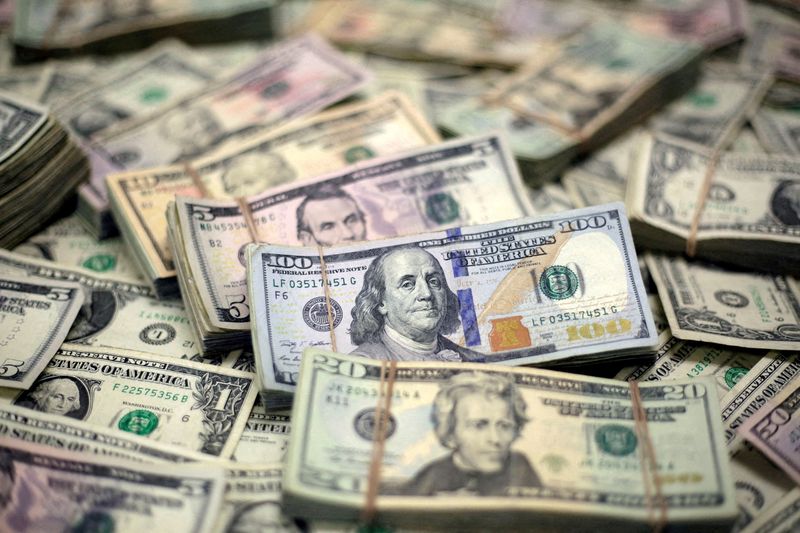By Gertrude Chavez-Dreyfuss
NEW YORK (Reuters) -The U.S. dollar edged higher against most major currencies on Tuesday, resuming the latest uptrend that took it to more than two-month highs fueled by expectations the Federal Reserve will proceed with modest interest rate cuts over the next year and a half.
The greenback traded lower for most of the European and U.S. sessions due in part to a decline in risk aversion after media reports said Israel was not willing to strike Iranian oil targets, easing fears of a supply disruption in the Middle East. That pushed oil prices lower and reduced inflation expectations, modestly pressuring the dollar.
Analysts, however, said the dollar's recent uptrend still has some ways to go given persistent geopolitical and election uncertainty.
"We think the trend for the greenback will remain intact as long as the macro data remains above water," said Boris Kovacevic, global macro strategist, at Convera in Vienna, Austria.
"Volatility ... and the U.S. dollar tend to rise in tandem going into the U.S. election, especially with the rise of (former U.S. President) Trump in betting markets and the 50 basis-point (bp) cut being out of the picture for the Fed at least in November. This would be the best case for the dollar in the short term."
U.S. data has shown a resilient economy, while inflation in September rose slightly more than expected, leading traders to trim bets on further large rate cuts from the Fed.
The U.S. central bank kicked off its easing cycle with an aggressive 50-bp move at its last policy meeting in September but market expectations have shifted to a slower pace of cuts, boosting the dollar.
Traders have assigned a nearly 100% chance of a 25 bps cut in November, with just a 0.2% probability of a pause by the Fed, keeping the fed funds rate at the 4.75%-5.0% target range, according to LSEG calculations.
The market has also factored 47 bps of rates easing this year, and another 100 bps of cuts in 2025, much lower than the 200 bps reductions priced in before the September Fed meeting.
In afternoon trading, the dollar index, which measures the U.S. currency against six rivals, was up 0.1% at 103.26, not far from 103.36, the highest level since Aug. 8 touched on Monday. The dollar was boosted in part by comments from Fed Governor Chris Waller, who called for "more caution" on interest rate cuts ahead.
The euro hit its lowest level since Aug. 8 at $1.0882 ahead of the European Central Bank policy meeting on Thursday, where the central bank looks set to deliver back-to-back rate cuts, a move that seemed unlikely at its last meeting in September. It was last down 0.2% at $1.0887.
The pound was marginally higher at $1.3068 in the wake of British labor market data showing pay grew at its slowest in more than two years in the three months to August. That pace that should allow the Bank of England to lower interest rates next month.
Expectations that sticky inflation would keep the BoE on a gradual rate cut path relative to its peers - the Fed and the ECB - had underpinned the pound's outperformance this year. But shifting bets have pushed it lower in recent weeks, with the pound down over 2% against the dollar for the month.
YEN WEAKNESS ABATES
The U.S. currency's rise has pushed the yen back toward 150 per dollar, especially after a dovish shift in rhetoric from Bank of Japan Governor Kazuo Ueda and surprising opposition to further rate hikes from new Prime Minister Shigeru Ishiba.
That has cast doubts as to when Japan's central bank will next tighten policy, with a very slim majority of economists in a Reuters poll expecting BOJ to forgo raising rates again this year.
The dollar fell 0.4% against the yen to 149.25 yen, having risen to 149.98 on Monday, its highest since Aug. 1. So far this month, the dollar has gained 3.8% versus the Japanese currency.
Oil-exporting currencies were weaker after crude oil prices plummeted on reports of Israel unwilling to strike Iranian targets.
Against the Norwegian crown, the dollar rose 0.3% to 10.827 , while the U.S. currency was flat against the Canadian dollar at C$1.3792.
Meanwhile, the Australian dollar fell 0.4% to US$0.6701, while the New Zealand dollar slid 0.3% to US$ $0.6078.
China's yuan, both onshore and offshore, weakened to a one-month low against the dollar on Tuesday. [CNY/]
Currency
bid
prices at
15
October
07:33
p.m. GMT
Descripti RIC Last U.S. Pct YTD Pct High Low
on Close Change Bid Bid
Previous
Session
Dollar 103.24 103.18 0.07% 1.84% 103.34 103.
index 03
Euro/Doll 1.0887 1.0909 -0.2% -1.37% $1.0917 $1.0
ar 882
Dollar/Ye 149.19 149.79 -0.33% 5.85% 149.8 148.
n 875
Euro/Yen 1.0887 163.35 -0.56% 4.37% 163.43 162.
35
Dollar/Sw 0.8625 0.8627 -0.01% 2.49% 0.8636 0.86
iss 08
Sterling/ 1.3067 1.3061 0.08% 2.72% $1.3103 $1.3
Dollar 038
Dollar/Ca 1.3792 1.3795 -0.02% 4.05% 1.3839 1.37
nadian 91
Aussie/Do 0.6701 0.6726 -0.36% -1.7% $0.6732 $0.6
llar 7
Euro/Swis 0.9391 0.9408 -0.18% 1.13% 0.941 0.93
s 83
Euro/Ster 0.8329 0.8352 -0.24% -3.88% 0.8356 0.83
ling 26
NZ 0.6079 0.6097 -0.27% -3.77% $0.6105 0.60
Dollar/Do 74
llar
Dollar/No 10.8289 10.7974 0.29% 6.85% 10.8596 10.7
rway 809
Euro/Norw 11.7904 11.7818 0.07% 5.05% 11.8248 11.7
ay 563
Dollar/Sw 10.4199 10.416 0.04% 3.51% 10.445 10.3
eden 53

Euro/Swed 11.3462 11.3636 -0.15% 1.97% 11.3815 11.2
en 94